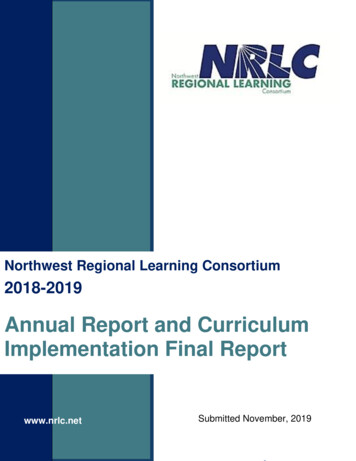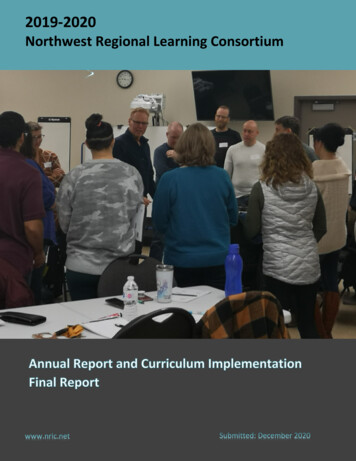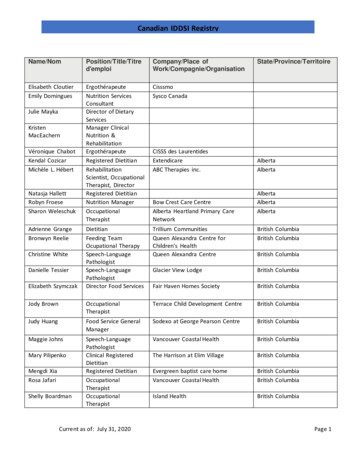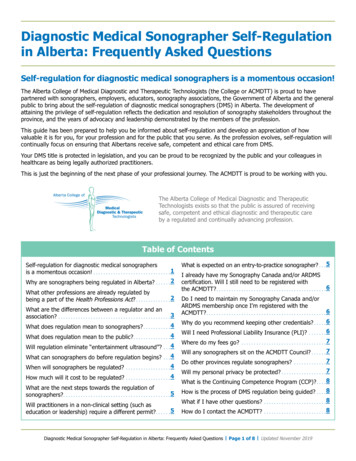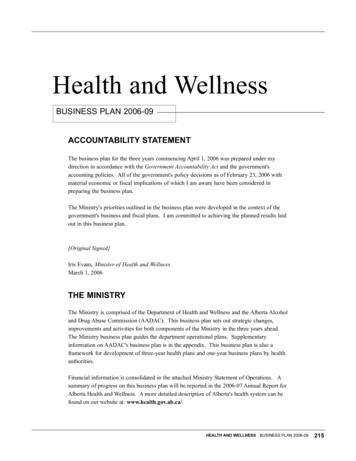
Transcription
Health and WellnessBUSINESS PLAN 2006-09ACCOUNTABILITY STATEMENTThe business plan for the three years commencing April 1, 2006 was prepared under mydirection in accordance with the Government Accountability Act and the government'saccounting policies. All of the government's policy decisions as of February 23, 2006 withmaterial economic or fiscal implications of which I am aware have been considered inpreparing the business plan.The Ministry's priorities outlined in the business plan were developed in the context of thegovernment's business and fiscal plans. I am committed to achieving the planned results laidout in this business plan.[Original Signed]Iris Evans, Minister of Health and WellnessMarch 1, 2006THE MINISTRYThe Ministry is comprised of the Department of Health and Wellness and the Alberta Alcoholand Drug Abuse Commission (AADAC). This business plan sets out strategic changes,improvements and activities for both components of the Ministry in the three years ahead.The Ministry business plan guides the department operational plans. Supplementaryinformation on AADAC's business plan is in the appendix. This business plan is also aframework for development of three-year health plans and one-year business plans by healthauthorities.Financial information is consolidated in the attached Ministry Statement of Operations. Asummary of progress on this business plan will be reported in the 2006-07 Annual Report forAlberta Health and Wellness. A more detailed description of Alberta's health system can befound on our website at: www.health.gov.ab.ca/.HEALTH AND WELLNESS BUSINESS PLAN 2006-09215
VISIONMISSIONAlbertans are healthy and live, work and play in a healthyenvironment.Provide leadership and work collaboratively with partners tohelp Albertans be healthy and respond to opportunities andchange.Support individuals, families and service providers inmaking the best decisions about their health.LINK TO THE GOVERNMENT OF ALBERTA STRATEGIC BUSINESS PLANThe Health and Wellness business plan is aligned with and supports the "Making Alberta the Best Place to Live, Work andVisit," strategic opportunity of the Government of Alberta 20-year strategic plan. The Health and Wellness business planlinks to the government business plan through: Albertans will be healthy (goal 5).Alberta will have a supportive and sustainable infrastructure that promotes growth and enhances quality of life(goal 14).SIGNIFICANT OPPORTUNITIES AND CHALLENGESThe Government of Alberta regards the health and well being of Albertans as the most important resource for the future.The Alberta government is committed to working towards providing Albertans with the best and most responsive publichealth system in Canada. Alberta is embarking on a Third Way in health care delivery to improve quality and access and toincrease choice. This made-in-Alberta approach to health care renewal focuses on evolving our health system byunleashing innovation, challenging the status quo and charting a new course. The Third Way is an evolving process withinitiatives and innovations created at local, regional and provincial levels and by all service providers.On July 12, 2005, the government unveiled a package of thirteen renewal initiatives called "Getting on with better healthcare". These initiatives include innovations in priority areas such as access, continuing care, wellness, mental health,primary care, children's health, pharmaceuticals, electronic health records and rural health.ChallengesPopulation Growth and Changing Demographics:Currently 10 per cent of Alberta's population is 65 years ofage and over and this percentage is expected to increase to13 per cent by 2016 and 20 per cent by 2030. Alberta hasone of the youngest populations in Canada. Yet, the effectof aging contributes approximately 1 per cent to annualhealth expenditure growth, but the larger cost driver is theexpansion of services provided to seniors.Additionally, Alberta's population is shifting from rural tourban centres and the province has one of the highestpopulation growth rates of approximately 1.5 per cent peryear.216HEALTH AND WELLNESS BUSINESS PLAN 2006-09OpportunitiesForesight and Innovation: Demographic shifts arepredictable and we are preparing for the needs of the futurewhile addressing the needs of today. Through innovativetechnology such as Telehealth and the Critical Care Linewe are better able to meet the needs of rural and remotecommunities.Alberta's excellent health care contributes to our longer lifeexpectancy. We have an opportunity to implement avariety of innovative care options for frail elderly andfragile people in collaboration with government ministries,health authorities and other stakeholders that will benefitAlbertans over the next 20 years.
ChallengesEmerging Technologies and Pharmaceuticals:Technological change is a major cost escalator in Canada'shealth systems accounting for an estimated one quarter ofhealth expenditure growth. Promising results from clinicaltrials into new drugs creates expectations of public funding.OpportunitiesCollaboration: We will work with health authorities,health care providers, and federal, provincial and territorialcolleagues to support a consistent, evidence-basedapproach for the evaluation of technology andpharmaceuticals. This approach will consider clinicalbenefits, cost effectiveness and ongoing benefits to patientsand the health care system.The role of government is to evaluate new emergingtechnologies and pharmaceuticals and ultimately decidewhich of these will be publicly funded. We will alsoexplore and evaluate the extent of drug insurance coverage,including pharmacare, to ensure all Albertans have accessto quality pharmaceutical services.Workforce Shortages: A quality health system requires anadequate supply of competent and progressive health careworkers. The workforce is aging, with 20 per cent ofRegistered Nurses over the age of 50. In addition, the workenvironment is continually changing and workers need tocontinually acquire new skills. Recent medical graduatesand female physicians are demanding greater work / lifebalance and are working fewer hours than physicians did inthe past, which increases the number of physicians neededto serve Alberta's population.New medical graduates are choosing to specialize instead ofentering family practice which is contributing to a shortageof primary care physicians.Partnerships: Continue to work with post-secondaryinstitutions, the health authorities and professionalassociations on plans and initiatives to educate, recruit,remunerate and retain the needed health workforce.Primary care initiatives are providing new incentives forfamily physicians and giving them an opportunity to workin multi-disciplinary teams. New regulations under theHealth Professions Act will allow allied health professionsto work to their full scope of practice.Rural communities continue to face difficulties in attractingand retaining an adequate supply of physicians and otherhealth workers.Work with stakeholders to address workforce issuesthrough the rural physician action plan. The plan seeks totrain and attract physicians to serve rural Alberta.Quality of Health Services: Quality improvement andpatient needs are a matter of concern to local, regional andprovincial health system leaders. Safeguards andmechanisms to anticipate and prevent adverse events suchas medication and technical errors must be strengthened.Culture of Quality: Develop supportive, organizational,professional and legal environments to encourage thereporting of adverse events and the prompt implementationof corrective action.The rapid and accurate transmission of health informationis part of the answer and tools such as the AlbertaElectronic Health Record can improve the quality andsafety of patient care.HEALTH AND WELLNESS BUSINESS PLAN 2006-09217
ChallengesOpportunitiesHealth Spending: Health spending balanced with anaccessible quality health care system. Health care spendinghas been increasing 2-3 times faster than the provincial realGDP growth rate.Accountable Spending: Achieving health systemsustainability requires cooperation and compromise on thepart of governing authorities' system managers,professional associations and bargaining units. Byleveraging the unique contributions of various partners, byensuring the best use of Alberta's knowledge andintellectual capital, and by developing innovative ways ofdelivering services, we will gradually bring healthexpenditures in line with anticipated funding.Public Health Risk: The capacity to deal with known (e.g.,SARS, West Nile virus) and unknown emergent publichealth risks (e.g., pandemic influenza).System Readiness and Flexibility: Enhance capacity torespond to public health risks through plannedcollaboration with health authorities, providers and federal,provincial, territorial and municipal governments.Aboriginal Health: Alberta's growing Aboriginalpopulation has a variety of health challenges. Delivery ofhealth services to remote or isolated Aboriginalcommunities is a challenge as is the provision of culturallyappropriate services within the health care system.Investment: Continue to implement and expand strategiesto improve Aboriginal health services in collaboration withAboriginal leaders, health authorities, service providers,and provincial and federal governments.Mental Health: One in five Canadians is affected bymental illness during their lifetime. The overall prevalenceof mental illness in Canadian children and adolescents atany given point in time is about 15 per cent. Mental illnesscan have a significant economic impact on individuals, theirfamilies, the health care system as well as the workplaceand broader social system.Collaboration: Collaborate with health authorities,service providers, and ministries to support regionalimplementation of the Provincial Mental Health Plan. TheMental Health Innovation Fund will improve mental healthservices in the province and improve patient access.Partners are addressing gaps in child and adolescent mentalhealth services. Support the inter-departmental familyviolence prevention initiatives.Addiction: Addictions affect all Albertans. Alcohol is themost frequently used drug in Alberta, and it is the drug mostcommonly associated with acute and chronic health andsocial problems. However, multiple drug use, new orunfamiliar drugs and increased gambling opportunities areof concern, particularly among youth.Investment and Collaboration: Continue to provideprovince-wide addiction services for Albertans. AADACwill lead the collaborative implementation of the AlbertaDrug Strategy, enhance provincial adolescent treatmentservices, and continue to partner with stakeholders toenhance services to those with addiction and mental healthproblems.Child and Youth Health: Previously, chronic diseases wereprimarily evident only in adult populations, but theincidence in child and youth populations is rapidlyincreasing, along with the associated costs to Albertans.Children who have health issues are more likely to strugglewith the same issues when they become adults.Prevention: Addressing the health problems of theyounger generation constitutes a sound investment for thefuture. New government programs will address unhealthybody weight, developmental problems, sexuallytransmitted infections and tobacco use. Another priorityincludes finding ways to limit children's access to sexualand violent content on the internet.218HEALTH AND WELLNESS BUSINESS PLAN 2006-09
STRATEGIC PRIORITIES 2006-09The Ministry's strategic priorities for the next three years have been identified. These priorities are in addition to theimportant ongoing core activities of the Ministry.1. Better health care– the Third WayLinkage:Goals 1, 2, 3, 4, 5and 6Alberta is embarking on a Third Way in health care delivery to improve quality and access andto increase choice. In fostering new ideas and approaches, we are encouraging everyone tolook for practical ways to make services more efficient, responsive and accessible to thosewho need them. The following actions identify innovative new approaches for the delivery ofhealth services:Goal 6Health policy – We need an overall health policy that focuses on wellness and personalresponsibility, defines what services are included in the publicly-funded health system, guidesour decisions and sets clear priorities.Goal 3Access and efficiency – While people get immediate care when there is an emergency, thismay not be the case for non-emergency situations. Work to streamline the processes, get rid ofbottlenecks and speed up access to important health services is underway.Goal 1, 2 and 3Wellness and injury prevention – Encourage Albertans to take greater personal responsibilityfor their own health and wellness. By choosing healthier lifestyles, Albertans will be able toprevent or delay the onset of chronic conditions. Healthy eating and active living, combinedwith decisions that reduce personal health risks, will improve quality of life and long-termhealth outcomes and decrease demands on the health system. Immunization is one of the mostcost effective medical interventions to prevent diseases. Strategies to improve immunizationrates in Alberta are necessary to eliminate/reduce vaccine preventable diseases in our province.Goal 1 and 2Children's health – It makes good sense to make children's health a top priority. We need totake action to improve the health of all children and especially those who are at risk – whetherthose risks involve violence in their communities, homes or schools, exposure to drugs andalcohol, unhealthy lifestyles, or not being immunized against common childhood diseases.Specific action will be taken to respond to the risks and harm associated with crystalmethamphetamine abuse.Goal 3Access to mental health services – One in five Albertans will be affected by mental illnessduring their lifetimes. The nine regional health authorities are developing their own plansbased on the Provincial Mental Health Plan. Commencing with the 2006-09 planning andreporting cycle, health regions will provide specific information about mental healthperformance and outcomes.Goal 6Electronic Health Record–Alberta Netcare – The Alberta Netcare system is absolutelyessential for moving ahead on a whole range of initiatives in the health system that will resultin better care, better decisions and safer health services. For Albertans, it means an end torepeat tests and the security that when they have a health problem, the people who are treatingthem have access to a complete picture of their health.HEALTH AND WELLNESS BUSINESS PLAN 2006-09219
Goal 4Primary health care – A comprehensive, coordinated approach to primary health care that isavailable 24 hours a day, seven days a week. Multi-disciplinary team delivery ensuresAlbertans get the right provider and the right services at the right time.Goal 6Legislation and regulations – Legislation and regulation changes need to be made to expandchoices for Albertans and remove barriers that stand in the way of further innovation.Goal 6Prescription drug costs and coverage – Drug costs are the fastest growing part of the healthcare budget. We need to look at how we are going to pay the bill for drugs now and in thefuture. At the same time, current government drug plans only cover about 18 per cent ofAlbertans including seniors, children and people with lower incomes. Most Albertans get theirprescription drugs covered through private insurance plans, but about 27 per cent of Albertanshave no coverage at all.Goal 5Continuing care quality – The emphasis for continuing care, both long-term care and homecare, will be on quality of service. Albertans expect their parents and grandparents will bewell cared for in places where they are respected and treated with dignity. In the longer termwe also need to look at new approaches for paying for long-term care including insuranceprograms or savings plans where people could invest now.Goal 4Health care providers – The provision of health care requires a well-trained and wellmotivated workforce of an appropriate size and mix. Compensation of the health workforce(including physicians) accounts for approximately 70 per cent of health system expenditures.Consequently, health workforce strategic and operational planning is critically important to thelong-term sustainability of the Alberta health care system.Goal 3Rural communities – Access to health care is a critical issue in rural communities and theyface special challenges in being able to provide the range of health care services people needand expect. The provincial government's Rural Development Strategy identifies health care asone of the fundamental pillars that must be addressed in order to preserve and sustain ruralcommunities.Goal 6Supplementary health insurance – Conduct research and consult with experts on insuranceprograms for continuing care, prescription drugs and other non-emergency health services.Supplementary health insurance would not be required to cover any medical emergencies ormedically necessary health services.Goal 1Improving Alberta’s Health System–The Third Way – Enhance the sustainability of thehealth system now and in the future by strengthening policy integration and collaborationacross ministries. The Ministry will lead this initiative, which is one of the eight Top Prioritiesof the three-year government business plan. Actions taken will include: Child and youth wellness strategy Common pharmaceutical framework Continuing care strategy Insurance program for continuing care, prescription drugs and other non-emergency healthservices.220HEALTH AND WELLNESS BUSINESS PLAN 2006-09
2. Strengthen publichealth riskmanagementcapabilities.Linkage: Goal 2Albertans want to know that their health system is prepared and able to protect them from risksto their health. Recent events such as the outbreak of avian influenza, SARS and West Nilevirus as well as a potential pandemic have reinforced the importance of strong public healthprograms. Albertans are partners in this effort. Key strategies for managing public health risksinclude:Goal 2Protect Albertans against communicable diseases – Strengthen and restructure systemcapacity to respond to public health issues and risks. Create a communications partnershipwith other ministries, municipalities, agencies, associations (e.g., Alberta Urban MunicipalitiesAssociation, Alberta Association of Municipal Districts and Counties) and other stakeholders toensure Albertans get timely information on how to protect themselves against all communicablediseases in case of a catastrophic event such as pandemic influenza.Goal 2Protect Albertans from environmental health risks – Protect Albertans from health risks inthe environment through education, regulatory enforcement and partnership with otheragencies.CORE BUSINESSES, GOALS, STRATEGIES & PERFORMANCE MEASURESCore Business One: Advocate and educate for healthy livingGOAL ONE1What it meansAlbertans make choices for healthier lifestylesThe health and wellness of Albertans is influenced by genetic factors, early childhood development,education, employment status, the environment and personal decisions about lifestyle behaviours. TheMinistry provides health information to Albertans to promote healthy lifestyle and quality of life choices.Strategies1.1 Support Albertans in making healthy lifestyle choices through information services likehealthyalberta.com.1.2 Collaborate with community stakeholders to strengthen the ability of individuals and communities toincrease healthy behaviours and reduce the risk of disease, illness and injury.1.3 Provide health and lifestyle information to help people make healthy choices to reduce the risk ofdisease and injury (e.g., Fetal Alcohol Spectrum Disorder, obesity, sexually transmitted infections, HIV).1.4 Ensure that addiction information, prevention and treatment services are available province-wide.1.5 Work with other ministries to target strategic health and wellness initiatives that address the health needsof children, youth, seniors, Aboriginal communities and Albertans with disabilities or who aredisadvantaged.HEALTH AND WELLNESS BUSINESS PLAN 2006-09221
Performance MeasuresLast 989 (2005)78 (2005)90809080908077.5 (2003)82.3 (2003)78.083.078.083.078.083.01.c HIV Rates: Age adjusted rate of newly reportedHIV cases (per 100,000 population)5.4 (2004)5.55.65.51.d STI Rates: Age adjusted rate of newly reportedsexually transmitted infections (per 100,000population)SyphilisGonorrheaChlamydia2.3 (2004)43.3 (2004)261 (2004)4.0502804.5703004.3602906.2 (2000-02)6.05.95.85.556 (2003)606570801.g Healthy Diet: Per cent of Albertans age 12 andover who eat at least 5 servings of fruit andvegetables each day39.1 (2003)404245501.h Healthy Weight: Per cent of Albertans age 18and over with “acceptable” body mass index(BMI)47 (2003)505152551.i Diabetes: Number of new cases of type 2diabetes (per 1,000 population at risk)General populationFirst Nations population4.5 (2001)9.0 (2001)4.38.74.38.74.28.64.18.51.j Alcohol Consumption: Per cent of Albertawomen who consumed alcohol during pregnancy4.0 (2002)3.53.23.001.a Self-reported health status: Per cent ofAlbertans reporting they are in “excellent, verygood, or good” health18-6465 20121.b Life Expectancy at birth: (in years)MaleFemale1.e Birth Weight: Per cent of low birth weightbabies1.f Exercise: Per cent of Albertans age 12 andover who are “active” or “moderately active”Notes:1.aSelf-reported health status is a good indicator of the health and well-being of Albertans. How people rate their own health isaffected by a variety of factors including chronic disease, disability, temporary illness and mental health.1.bLife expectancy at birth indicates how long a newborn would be expected to live if health and living conditions remainunchanged. It reflects an equitable distribution of wealth in the population, good nutrition, education and environmentalconditions.1.c-1.d Due to the rising rate of all STIs, a further rise is anticipated in both STI and HIV, potentially peaking in 2007 and then declining.These increasing rates are similar nationally and internationally. The targets represent a slowing in the rate of increase.1.eA low birth weight is 2500 grams or less. Low birth weight babies are more likely to have birth related complications, disabilitiesand other health problems. They are also at a greater risk of having developmental delays and health problems.1.f-1.i Chronic diseases such as cancer and diabetes are leading causes of death in Alberta, and the greatest drain on our health careresources. The most common chronic diseases are linked by a few risk factors: unhealthy diets, lack of exercise, tobacco use andsubstance abuse. If we can make healthier choices we can move closer to the vision of Albertans are healthy and live, work andplay in a healthy environment. The 2012 targets are from the Framework for a Healthy Alberta.1.hAn "acceptable" BMI falls in the normal weight range. There are four categories of BMI ranges in the Canadian weightclassification system. They are: underweight (BMIs less than 18.5); normal weight (BMIs 18.5 to 24.9); overweight (BMIs 25 to29.9), and obese (BMI 30 and over). Most adults with a high BMI (overweight or obese) have a high percentage of body fat.Extra body fat is associated with increased risk of health problems such as diabetes, heart disease, high blood pressure and somecancers.1.jConsuming alcohol during pregnancy can result in fetal alcohol spectrum disorder (FASD). A baby born with FASD can haveserious handicaps and therefore could require a lifetime of special care. Alberta's goal is to have zero per cent of women consumealcohol during pregnancy by 2012.222HEALTH AND WELLNESS BUSINESS PLAN 2006-09
GOAL TWO2What it meansAlbertans' health is protectedThe Ministry monitors the health system and provides leadership and planning for prevention servicesdelivered through health authorities and other partners. As public health issues such as avian influenzagain attention worldwide, Albertans need to know their health system is ready and able to protect them.The Ministry provides support and leadership in the development of the overall provincial response andemergency plans to deal with outbreaks and health threats. These services help to protect Albertans fromdisease and injury.Strategies2.1 Reduce suicide and the risk of serious injury through education and targeted interventions incollaboration with other agencies. Work with AADAC, Children's Services, and Solicitor General andPublic Security to reduce the number of youth suicides.2.2 Protect Albertans against communicable diseases by strengthening the health system's capacity toprevent, be prepared for and respond to public health risks such as vaccine-preventable diseases,emerging threats like avian influenza and increases in sexually transmitted infections.2.3 Protect Albertans from environmental health risks transmitted via air, water, food and physicalenvironments through education, environmental and air quality monitoring, regulatory compliance andenforcement in partnership with other ministries.2.4 Develop networks and initiatives that improve access to disease screening and prevention services suchas the Alberta Stroke Network.2.5 Work with other ministries on the Water for Life Strategy to ensure safe and secure drinking water forAlbertans.2.6 Develop a provincial immunization strategy that would lead to improved immunization rates amongAlbertans.2.7 Conduct health surveillance; assess and report on health trends in selected health priority areas (e.g., areproductive health report, a West Nile Virus report, an updated children's health status report, and aninjury report).2.8 Work with other ministries to reduce the transmission of infection in the provision of health care andother community services (e.g., day cares).2.9 Utilize funding from the Alberta Cancer Prevention Legacy Fund to put Alberta at the forefront of cancerprevention, screening and research.HEALTH AND WELLNESS BUSINESS PLAN 2006-09223
Performance MeasuresLast 912.2 (2003)13.9 (2003)12.013.912.013.712.013.52.b Childhood immunization coverage rates: (percent by 2 yrs of age):Diphtheria, tetanus, pertussis, polio, HibMeasles, mumps, rubella78 (2003)90 (2003)8893939697*982.c Influenza vaccination: Per cent who havereceived the recommended annual influenza (flu)vaccineSeniorsChildren 6-24 months old69 (2004-05)40 (2004-05)7045725075602.d Screening rate for breast cancer: Per cent ofwomen age 50-69 receiving screeningmammography every two years (excludesmammograms done for diagnostic purposes)52.4 (2003)6062622.a Mortality Rates: (per 100,000 population)Land Transport AccidentsSuicideNotes:2.a Raise awareness of the significant burden motor vehicle collisions and suicide have on society and assure Albertans that actions willbe taken to impact these behaviours. Along with Infrastructure and Transportation and the RCMP, the Ministry funds and supportsthe work of the Alberta Occupant Restraint Program through the Alberta Centre for Injury Control and Research.2.b Providing immunizations for childhood vaccine-preventable diseases is a major activity of the public health system. Immunizationsprotect children and adults from a number of vaccine-preventable diseases, some of which can be fatal or produce permanentdisabilities. A high rate of coverage is needed to protect the entire community from outbreaks of these diseases. Immunizations alsoprovide the parents of young children with the opportunity to obtain other needed health information and advice during clinic visits.* Long-term target is 97 per cent (by 2009) as outlined in the Alberta Immunization Manual, 2001 in accordance with nationalstandards.2.c Influenza has a significant seasonal impact on the health of Albertans and tends to be most severe among children 6 to 24 months ofage, older Albertans, residents of long-term care facilities and those with certain chronic conditions. Illness and death from influenzais more likely in these populations, which affects acute care hospitals and emergency departments.2.d Education and screening reduces the rate of breast cancer among women from 50-69 years of age. The screening rate is anappropriate indicator of the effectiveness of the health system to detect cancer as soon as possible.New Performance Measure under development: The Alberta Cancer Board will be developing a screening program andmeasure for colorectal cancer. There are no data collected on a provincial basis at this time.Core Business Two: Provide quality health and wellness servicesGOAL THREE3What it means224Improved access to health servicesAlbertans expect health services will be accessible where and when they are needed. Working withhealth authorities and service providers, federal and provincial governments, Health and Wellness setsaccess standards for the health system. Improved access includes waiting time and geographic accessstandards and options in health services. These standards and their targets are as interconnected as thehealth system itself, and each target affects other health services.HEALTH AND WELLNESS BUSINESS PLAN 2006-09
Strategies3.1 Provide for continuing care services that allow Albertans to "age-in-place" in their homes andcommunities: work with regions to coordinate access to continuing care services for facility living, supportiveliving and home living; consolidate and modernize continuing care policy and regulations; collaborate with the Ministry of Seniors and Community Supports to address barriers/access tocontinuum of care and encourage innovation; expand community-based and home care services to enable individuals to remain in theircommunities as long as possible; and develop a new appro
HEALTH AND WELLNESS BUSINESS PLAN 2006-09 215 Health and Wellness ACCOUNTABILITY STATEMENT The business plan for the three years commencing April 1, 2006 was prepared under my direction in accordance with the Government Accountability Actand the government's accounting policies. All of the government's policy decisions as of February 23, 2006 with
